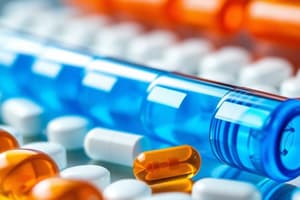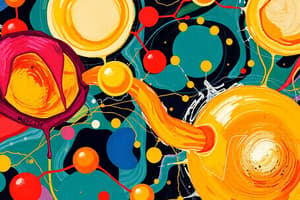Podcast
Questions and Answers
L-dopa directly crosses the blood-brain barrier without any modifications.
L-dopa directly crosses the blood-brain barrier without any modifications.
False (B)
Dopamine can efficiently cross the blood-brain barrier due to its low polarity.
Dopamine can efficiently cross the blood-brain barrier due to its low polarity.
False (B)
The prodrug form of 2-PAM can be administered orally to achieve significant levels in the brain.
The prodrug form of 2-PAM can be administered orally to achieve significant levels in the brain.
False (B)
L-dopa is converted to its active form, dopamine, in the brain after crossing the blood-brain barrier.
L-dopa is converted to its active form, dopamine, in the brain after crossing the blood-brain barrier.
Direct administration of dopamine leads to significant concentrations in the central nervous system.
Direct administration of dopamine leads to significant concentrations in the central nervous system.
Peripheral side effects of L-dopa are caused by its conversion to dopamine outside the brain.
Peripheral side effects of L-dopa are caused by its conversion to dopamine outside the brain.
2-PAM, a cationic species, is able to access the brain easily after intravenous administration.
2-PAM, a cationic species, is able to access the brain easily after intravenous administration.
L-dopa serves as a chemical delivery system for dopamine to reach the brain.
L-dopa serves as a chemical delivery system for dopamine to reach the brain.
Oxidative deamination significantly increases the concentration of dopamine in the brain.
Oxidative deamination significantly increases the concentration of dopamine in the brain.
Chemical delivery systems for drugs can help to minimize the side effects associated with direct drug administration.
Chemical delivery systems for drugs can help to minimize the side effects associated with direct drug administration.
Pro-2-PAM is an ester derivative that undergoes conversion to the active drug 2-PAM.
Pro-2-PAM is an ester derivative that undergoes conversion to the active drug 2-PAM.
The oxidation process of pro-2-PAM occurs primarily in the brain and not in peripheral tissues.
The oxidation process of pro-2-PAM occurs primarily in the brain and not in peripheral tissues.
IV administration of pro-2-PAM results in brain levels of 2-PAM that are significantly higher than those achieved by IV administration of the parent drug.
IV administration of pro-2-PAM results in brain levels of 2-PAM that are significantly higher than those achieved by IV administration of the parent drug.
The resulting cationic drug species from pro-2-PAM oxidation can easily diffuse out of the brain.
The resulting cationic drug species from pro-2-PAM oxidation can easily diffuse out of the brain.
Amides of dihydropyridine carboxylic acids are frequently used to deliver drugs to the CNS.
Amides of dihydropyridine carboxylic acids are frequently used to deliver drugs to the CNS.
The dihydropyridine derivative can access the CNS through passive absorption of a quaternary amine.
The dihydropyridine derivative can access the CNS through passive absorption of a quaternary amine.
Amide hydrolysis is the faster metabolic event compared to dihydropyridine oxidation.
Amide hydrolysis is the faster metabolic event compared to dihydropyridine oxidation.
The delivery of the drug-dihydropyridine derivative to the brain is a multistep process.
The delivery of the drug-dihydropyridine derivative to the brain is a multistep process.
Functional groups can be added to the dihydropyridine to facilitate conversions to various CNS drugs.
Functional groups can be added to the dihydropyridine to facilitate conversions to various CNS drugs.
The nonionic nature of pro-2-PAM prevents it from crossing the blood-brain barrier.
The nonionic nature of pro-2-PAM prevents it from crossing the blood-brain barrier.
The activity of glucosidase in colon bacteria enables the hydrolysis of glucoside derivatives of drugs in the lower GI tract.
The activity of glucosidase in colon bacteria enables the hydrolysis of glucoside derivatives of drugs in the lower GI tract.
The polar glucoside derivatives of steroids are easily absorbed into the bloodstream from the GI tract.
The polar glucoside derivatives of steroids are easily absorbed into the bloodstream from the GI tract.
Enzymatic systems in normal tissues often exhibit higher activity than those in tumor cells.
Enzymatic systems in normal tissues often exhibit higher activity than those in tumor cells.
Deriving drug molecules with amino acid or peptide fragments can result in improved rates of drug incorporation into tumors.
Deriving drug molecules with amino acid or peptide fragments can result in improved rates of drug incorporation into tumors.
The presence of enzymes in normal tissue allows for complete site specificity when delivering drugs to tumors.
The presence of enzymes in normal tissue allows for complete site specificity when delivering drugs to tumors.
Higher glucosidase activity in colon bacteria is less beneficial for drug delivery compared to other enzymatic systems found in normal tissues.
Higher glucosidase activity in colon bacteria is less beneficial for drug delivery compared to other enzymatic systems found in normal tissues.
Steroid drugs administered as glucoside derivatives demonstrate less effectiveness in the lower GI tract after modification.
Steroid drugs administered as glucoside derivatives demonstrate less effectiveness in the lower GI tract after modification.
Proteolytic enzymes are among those systems that have lower activity in and near tumor cells compared to normal tissue.
Proteolytic enzymes are among those systems that have lower activity in and near tumor cells compared to normal tissue.
Incorporating drugs with amino acids enhances their effectiveness in targeting tumor cells.
Incorporating drugs with amino acids enhances their effectiveness in targeting tumor cells.
The glucosidase activity found in colon bacteria allows for lower concentrations of drugs in the colon.
The glucosidase activity found in colon bacteria allows for lower concentrations of drugs in the colon.
Flashcards
Prodrug
Prodrug
A drug that is inactive until metabolized in the body to its active form.
L-Dopa
L-Dopa
L-Dopa is a prodrug used to treat Parkinson's disease. It is converted into dopamine in the brain.
Decarboxylation of L-Dopa
Decarboxylation of L-Dopa
The process of converting L-Dopa into dopamine in the brain.
Blood-Brain Barrier
Blood-Brain Barrier
Signup and view all the flashcards
L-Dopa Transport in the Brain
L-Dopa Transport in the Brain
Signup and view all the flashcards
Dopamine Limitations
Dopamine Limitations
Signup and view all the flashcards
Pro-2-PAM
Pro-2-PAM
Signup and view all the flashcards
2-PAM Limitations
2-PAM Limitations
Signup and view all the flashcards
Site-Specific Chemical Delivery System
Site-Specific Chemical Delivery System
Signup and view all the flashcards
L-Dopa as a Delivery System
L-Dopa as a Delivery System
Signup and view all the flashcards
Drug Delivery to the Colon
Drug Delivery to the Colon
Signup and view all the flashcards
Steroid Drug Delivery
Steroid Drug Delivery
Signup and view all the flashcards
Drug Delivery to Tumors
Drug Delivery to Tumors
Signup and view all the flashcards
Targeting Tumor Cells
Targeting Tumor Cells
Signup and view all the flashcards
Limitations of Tumor-Targeted Drugs
Limitations of Tumor-Targeted Drugs
Signup and view all the flashcards
What is Pro-2-PAM?
What is Pro-2-PAM?
Signup and view all the flashcards
How does Pro-2-PAM cross the blood-brain barrier?
How does Pro-2-PAM cross the blood-brain barrier?
Signup and view all the flashcards
How is 2-PAM 'trapped' in the brain?
How is 2-PAM 'trapped' in the brain?
Signup and view all the flashcards
Where does the oxidation of Pro-2-PAM occur?
Where does the oxidation of Pro-2-PAM occur?
Signup and view all the flashcards
Why is IV administration of pro-2-PAM superior?
Why is IV administration of pro-2-PAM superior?
Signup and view all the flashcards
How is the dihydropyridine ring used for drug delivery?
How is the dihydropyridine ring used for drug delivery?
Signup and view all the flashcards
What are the steps in the dihydropyridine-based drug delivery system?
What are the steps in the dihydropyridine-based drug delivery system?
Signup and view all the flashcards
How can the dihydropyridine ring be modified?
How can the dihydropyridine ring be modified?
Signup and view all the flashcards
What type of derivatives is often used for delivering amines?
What type of derivatives is often used for delivering amines?
Signup and view all the flashcards
What is the benefit of using amide derivatives?
What is the benefit of using amide derivatives?
Signup and view all the flashcards
Study Notes
Prodrugs
- Prodrugs are site-specific chemical delivery systems that deliver a drug to the brain
- L-dopa is an example of an amino acid drug, considered a prodrug
- The brain has an active transport system that incorporates L-amino acids into the central nervous system (CNS)
- L-dopa is transported into the brain through this system
- In the brain, L-dopa undergoes decarboxylation, yielding dopamine, the active metabolite
- Dopamine does not cross the blood-brain barrier efficiently
- Dopamine is rapidly metabolized by oxidative deamination
- Direct systemic administration of dopamine does not produce significant levels of dopamine in the brain due to its high polarity and poor membrane permeability, and facile metabolic degradation by oxidative deamination
- Dopamine formed inside the blood-brain barrier is held there due to poor membrane permeability
- The enzyme activating system for L-dopa is not localized at the target site, leading to undesirable side effects in other tissues and organs
- Pro-2-PAM (2-PAM) is another example of a prodrug used for the central nervous system (CNS)
- Pro-2-PAM is a dihydropyridine derivative that undergoes metabolic and chemical oxidation to yield 2-PAM, the active drug
- Polar properties of 2-PAM prevent its absorption after oral administration and restrict drug access to the brain even after intravenous administration
- Nonionic pro-2-PAM easily crosses the blood-brain barrier and oxidation to 2-PAM within the brain traps the active cationic drug inside
- Oxidation of the dihydropyridine ring of pro-2-PAM occurs throughout the mammalian system
- IV administration of pro-2-PAM results in 2-PAM brain levels approximately 10 times higher than after IV administration of the parent drug
- The chemical delivery of drugs to the CNS occurs through a multistep process
- Delivery of the drug-dihydropyridine derivative to the brain via facile diffusion across the blood-brain barrier
- Followed by oxidation to the quaternary pyridine cation, trapped in the brain
- The drug is then released from the pyridine cation by a second metabolic/chemical event
- Functional groups can be added to dihydropyridines to facilitate the derivatization of various functional groups found in CNS drugs
- Many CNS drugs are amines or amides of dihydropyridine carboxylic acids, often prepared to deliver the drugs across the blood-brain barrier
- These forms are used to protect the amines from metabolic degradation before they reach the target site
- The dihydropyridine derivative of a dopamine ester passes into the CNS through passive absorption of the tertiary amine
- Oxidation restricts the resulting pyridinium amide to the brain
- Hydrolysis delivers the active form of the drug near its Site of action
- Amide hydrolysis step may be slower than the dihydropyridine oxidation step
Colon and Lower GI Tract
- Drugs can be delivered to the colon and lower GI tract using the unique enzymatic processes of the colon bacteria
- Glucosidase activity of colon bacteria allows hydrolysis of glucoside derivatives
- Higher concentrations of active drug result in the colon
- Steroid drugs are often administered as glucoside derivatives for increased effectiveness in the lower GI tract
Tumor Delivery
- Tumor cells often have higher enzymatic activity than normal tissue, particularly peptidases and proteases
- To deliver drugs to tumors, one method is to derive a drug molecule with an amino acid or peptide fragment.
- Presence of enzymes in normal tissue prevents complete site specificity for these agents
Studying That Suits You
Use AI to generate personalized quizzes and flashcards to suit your learning preferences.




